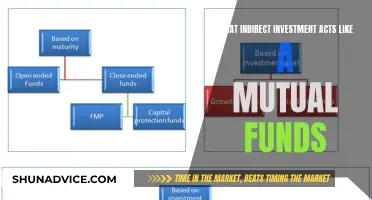
Mutual funds are a great way to maximise your earning potential. They are a type of investment program funded by shareholders that trade in diversified holdings and are managed by a professional fund manager. In the Philippines, mutual funds can be categorised into four basic types: stock/equity, balanced, bond, and money market funds. Each type of fund has a different level of risk and potential return, so it's important to understand the options before investing. The advantages of investing in mutual funds include the ability to start with a small capital, earning a passive income, gaining trust fund for kids, liquidity in investment, expert fund managers, flexibility, promising diversification, and the potential for higher returns. However, there are also some disadvantages, such as capital depreciation and the lack of control over your securities. Overall, mutual funds are a popular investment vehicle in the Philippines, offering a convenient and well-regulated way to grow your money.
| Characteristics | Values |
|---|---|
| Definition | A mutual fund is an investment program funded by shareholders that trades in diversified holdings and is managed by a professional fund manager. |
| Investor Profile | Ideal for young professionals or investment newbies who don't need to be millionaires to start investing. |
| Types | Stock/Equity, Balanced, Bond, and Money Market Funds |
| Benefits | Start with a small capital, earn a passive income, gain a trust fund for kids, liquidity in investment, expert fund managers, flexibility, promising diversification, possible higher returns, and convenient investments. |
| Drawbacks | Capital depreciation, lack of control over securities, time taken for redemption of shares, and no assured return on investment. |
| Top Companies | Philam, Sun Life, Soldivo, Philequity, FAMI, Cocolife Asset Management Co. Inc., MBG Equity Investment Fund, Inc., and Grepalife Asset Management Corporation. |
What You'll Learn

Types of mutual funds in the Philippines
Mutual funds in the Philippines can be broadly categorized into four types: stock/equity, balanced, bond, and money market funds. Each type caters to different investment goals, risk appetites, and instruments where the pooled funds are invested. Here's a closer look at each type:
- Stock/Equity Funds: These funds are considered to have the highest risk but offer the potential for substantial returns over the long term (typically five years or more). They primarily invest in stocks and equities, targeting specific sectors for stock investment in some cases. This type of fund is ideal for investors with a higher risk appetite and a longer investment timeframe.
- Balanced Funds: Also known as hybrid funds, balanced funds invest in a combination of stocks, bonds, and other securities. A typical allocation is 60% stocks and 40% bonds. These funds are suitable for investors with a low to moderate risk appetite who seek higher returns than those offered by bond funds. The investment timeframe for balanced funds is usually around three to five years.
- Bond Funds: Bond funds, also referred to as debt funds, invest in bonds and other debt instruments such as treasury notes, government securities, and commercial papers. They offer moderate returns with lower volatility compared to stock funds. Bond funds are ideal for investors with low to moderate risk appetites who want to protect their savings against inflation.
- Money Market Funds: This type of mutual fund is considered the safest option but typically generates the lowest returns. Money market funds invest in short-term, high-quality debt securities such as certificates of deposits, treasuries, bankers' acceptances, and repurchase agreements. They are generally recommended for investors with a lower risk appetite and a short-term investment horizon.
When choosing a type of mutual fund, it's important to evaluate your financial goals, risk tolerance, and investment timeframe. Each type of fund has its own characteristics, and selecting the right one can help you align your investments with your financial objectives.
Smart Strategies for Investing in Low-Cost Mutual Funds
You may want to see also

Advantages of investing in mutual funds
Mutual funds are a great way for Filipinos to start investing. Here are some of the advantages of investing in mutual funds:
- Professional Management: Mutual funds are managed by full-time professional fund managers who have the expertise to make strategic trading decisions, optimise asset allocation, and seek interest earnings and dividend yields to maximise returns. This is especially beneficial for small investors who may not have the time or expertise to manage their investment portfolio.
- Low Capital Requirement: Mutual funds have a low barrier to entry, with some requiring a minimum initial investment of only ₱1,000 and additional investments as low as ₱500. This makes mutual funds accessible to a wider range of individuals, including those with limited funds.
- Equal Opportunity: Mutual funds provide equal opportunities for investors to grow their wealth, regardless of the amount they invest. The rate of return is proportionate to the investment, so everyone benefits from the fund's performance.
- Instant Diversification: Mutual funds invest in a wide array of securities, providing instant diversification for investors. This helps to mitigate risk and protect investors from the volatility of individual securities and industries.
- Liquidity: Mutual funds are highly liquid investments in the Philippines, allowing investors to easily convert their investments into cash. Redemption proceeds are typically provided within a few banking days.
- Safety and Security: Mutual funds in the Philippines are highly regulated by the Securities and Exchange Commission (SEC) under the Investment Company Act, prohibiting them from investing in certain risky products. They are required to submit regular reports to the SEC and their shareholders, ensuring transparency and accountability.
- Potentially Higher Returns: Mutual funds can take advantage of economies of scale, negotiating lower fees and commanding higher interest rates. Combined with the expertise of professional fund managers, this can lead to higher returns compared to individual investments.
- Convenience: Mutual funds offer convenience through easy purchasing options, such as brokers, financial planners, banks, insurance agents, and online platforms. They also provide additional services, such as account statements, tax information, and 24-hour access to fund information.
- Global Investment Exposure: Mutual funds allow Filipinos to invest in global stocks and multi-asset ETFs without the burden of extensive paperwork and large amounts of capital typically required for direct participation in these markets.
- Tax Benefits: Investing in mutual funds can have tax advantages in the Philippines. Gains realised upon redemption of mutual fund shares are excluded from the definition of gross income and are not subject to personal income tax.
Highway Trust Fund: Where Does the Money Go?
You may want to see also

Disadvantages of investing in mutual funds
Mutual funds are a popular investment choice, offering many advantages such as advanced portfolio management, dividend reinvestment, and risk reduction. However, there are also several disadvantages to consider before investing.
High Fees and Charges
Mutual funds come with various fees and charges that can impact your overall investment returns. These include annual fees, expense ratios, and commissions. The expense ratio, in particular, can be quite high, with some funds charging over 1.5%. It's important to be cautious of these fees as they can significantly reduce your profits.
Tax Inefficiency
Mutual funds are also known for their tax inefficiency. Investors typically have to pay taxes on capital gains and dividends received from the fund, which can further eat into your returns. Additionally, mutual funds themselves may be subject to taxes, which are then passed on to the investors.
Poor Trade Execution
Mutual funds are traded only once per day at the closing net asset value (NAV). This means that investors looking for faster execution times, such as those engaging in day trading, may find mutual funds unsuitable for their needs. The lack of flexibility in trading times can be a significant disadvantage for certain investors.
Potential Management Abuses
Another risk associated with mutual funds is the potential for management abuses. As investors, you are handing over control of your investments to fund managers, who may engage in practices such as churning, turnover, and window dressing. These practices can negatively impact the performance of your investments and lead to losses.
Lack of Control
When you invest in mutual funds, you give up control over your investment decisions to the fund manager. This means you cannot actively manage your portfolio or make strategic decisions. For some investors, this lack of control and involvement in the investment process can be a significant disadvantage.
Potential Risks and Losses
While mutual funds are generally considered low-risk investments, there is still the possibility of losing money. The value of your investment can depreciate, and you may experience losses due to market conditions or poor fund performance. Returns are not guaranteed, and even low-risk mutual funds offer only minimal returns.
Tax Benefits of Investing in Mutual Funds
You may want to see also

How to earn from investing in mutual funds
There are a few ways to earn money from investing in mutual funds in the Philippines. Firstly, you can earn through dividends. A mutual fund can earn profits from dividends on stocks or interest on assets. The fund will then pay you most of the income, minus any expenses incurred. You can receive this payment via check or choose to reinvest the profit to purchase more shares. Secondly, when a fund sells securities that have increased in value, it earns a capital gain. At the end of the year, these gains are distributed to investors, minus any capital losses. Lastly, your earnings are represented by the increased net asset value (NAV) of the fund. The NAV is the fund's per-unit market value, so if the market value of the fund's portfolio rises, the value of the fund and its shares also increase.
It's important to note that your potential earnings are subject to fees and charges as outlined in the terms and conditions of your chosen mutual fund company.
Investment Fund Certificate: What You Need to Know
You may want to see also

How to open a mutual fund account
Opening a mutual fund account is a relatively straightforward process. Here are the steps you can follow:
- Select a Fund: Choose a mutual fund company that aligns with your investment goals and risk tolerance. Research and compare different funds' performance, fees, and investment strategies.
- Open an Account and Fund Your Investment: Visit the website of your chosen mutual fund company and navigate to the account opening section. Fill out the required forms, such as the Account Opening Form (AOF) and Investment Application Form (IAF). Provide necessary identification and financial documentation. Fund your account by depositing the required minimum amount, which can range from PHP 1,000 to PHP 5,000.
- Submit Requirements: Submit the completed forms and documents to the mutual fund company's office or through authorized channels, such as a courier or their partner banks.
- Manage Your Investment: Once your account is opened, you can adjust your investment by adding more funds, redeeming (withdrawing) investments, or transferring your investment to another fund offered by the same company.
Alternatively, you can invest in mutual funds indirectly through a fund "supermarket," such as COL Fund Source or First Metro's Fundsmart. These platforms offer a wide range of mutual funds from different companies, allowing you to open a single account and access various funds. This option is more efficient and convenient, as it eliminates the need to open multiple accounts with different fund companies.
Best Mutual Funds to Invest in This Year
You may want to see also
Frequently asked questions
A mutual fund is an investment program funded by shareholders that trade in diversified holdings and are managed by a professional fund manager. It pools together a group of individuals and invests their money in stocks, bonds, and other securities.
There are four types of mutual funds in the Philippines: stock/equity, balanced, bond, and money market funds.
There are several advantages to investing in mutual funds, including the ability to start with a small capital, earning a passive income, gaining trust fund for kids, liquidity in investment, expert fund managers, flexibility, promising diversification, and potential for higher returns.







